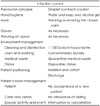Abstract
Objectives
In this study, we propose effective policies for preventing transmission in the closed ward of psychiatry department at the subject hospital.
Methods
15 patients (9 in 2010, 3 in 2012, and 3 in 2013) infected by 2009 H1N1 Influenza A were treated with Tamiflu® (Roche), and preventive Tamiflu® was administered to patients without symptoms as well as healthcare workers. Infected patients were placed in cohorts or isolation rooms with droplet and contact precautions. The ward was cleaned daily with chloride. Influenza vaccinations were administered to immunosuppressed patients and long-term patients. In addition, respiratory etiquette posters were posted on the closed ward during the latter half of 2012. The 2013 outbreak involved the same controls as 2012.
Results
The incidence of outbreak among patients during the three outbreaks was 53%, 18%, and 19%. The incidence of infection among healthcare workers was 0% throughout the three periods, and there was no additional infection.
Conclusion
In a closed ward of the psychiatry department, there is constant contact between healthcare workers and patients. Therefore, the possibility of influenza transmission is expected to be high. It is important to maintain constant inspection to detect outbreaks. Effective infection control should be applied to block the virus.
Figures and Tables
 | Fig. 1The number of cases and incidence of infected patients during the outbreak periods of 2009 H1N1 Influenza A virus. |
Table 1
Isolation characteristics of inpatients during three 2009 Influenza A (H1N1) outbreak periods

Table 3
Vaccination and antiviral medications for inpatients during 2009 Influenza A (H1N1) outbreak period

Table 4
Vaccination and antiviral medication for health professional during 2009 Influenza A (H1N1) outbreak period

Table 5
Demographic characteristics of 2009 Influenza A (H1N1) infected patients during outbreak period

References
1. Neumann G, Noda T, Kawaoka Y. Emergence and pandemic potential of swine-origin H1N1 influenza virus. Nature. 2009; 459:931–939.

2. Kim WJ. Novel influenza A/H1N1 pandemic: current status and prospects. J Korean Med Assoc. 2009; 52:787–794.

3. Gilbride SJ, Lee BE, Taylor GD, Forgie SE. Successful containment of a norovirus outreak in an acute adult psychiatric area. Infect Control Hosp Epidemiol. 2009; 30:289–291.

4. Hota S, McGeer A. Antivirals and the control of influenza outbreaks. Clin Infect Dis. 2007; 45:1362–1368.

5. Kim HJ, Chun BC, Hann HJ, Sohn JW, Kee SY, Kim SH, et al. Incidence and epidemiological characteristics of 2009 pandemic Influenza A (H1N1) among school-based populations in Korea. Infect Chemother. 2012; 44:431–438.

6. Hong MJ. Characteristics and transmission route of 2009 influenza H1N1 virus infected healthcare personnels in one tertiary care hospital [dissertation]. Ulsan: University of Ulsan;2012.
7. Lim DY, Jeong JS, Park JH, Woo JH. Infection control preparedness for influenza A pandemic (H1N1) 2009 in healthcare settings. Korean J Nosocomial Infect Control. 2010; 15:78–86.
8. Yoon YH, Choi SH, Cho HJ, Kim JY, Han C, Lee KH, et al. H1N1 influenza: hospital countermeasures and the need for planning. J Korean Soc Emerg Med. 2011; 22:72–78.
9. Zoutman DE, Ford BD, Melinyshyn M, Schwartz B. The pandemic influenza planning process in Ontario acute care hospitals. Am J Infect Control. 2010; 38:3–8.

10. Wise ME, Marquez P, Sharapov U, Hathaway S, Katz K, Tolan S, et al. Outbreak of acute hepatitis B virus infections associated with podiatric care at a psychiatric long-term care facility. Am J Infect Control. 2012; 40:16–21.

11. Nováková V, Cantero-Caballero M, Zoni AC, Plá-Mestre R, Olmedo-Lucerón Mdel C, Rodríguez-Pérez P. Epidemic keratoconjunctivitis outbreak in a closed psychiatric ward. Infect Control Hosp Epidemiol. 2013; 34:764–765.

12. Kim SH, Park CH, Huh K, Shim GH, Kim HB, You SJ, et al. Comparison of clinical manifestation and laboratory findings between H1N1 and influenza B infection. Pediatr Allergy Respir Dis. 2012; 22:64–70.

13. Lee BK, Ju JK, Choi BS, Jung SG, Jung JA, Yun HJ. Usefulness of influenza rapid antigen test in influenza A (H1N1). Pediatr Allergy Respir Dis. 2012; 22:71–77.

14. Park GH, Park SB, Kim SW. The sensitivity according to the time gap between fever onset and the performance of rapid antigen test for 2009 H1N1 influenza. Pediatr Allergy Respir Dis. 2012; 22:21–26.

15. Lee S, Chowell G, Castillo-Chávez C. Optimal control for pandemic influenza: the role of limited antiviral treatment and isolation. J Theor Biol. 2010; 265:136–150.





 PDF
PDF ePub
ePub Citation
Citation Print
Print





 XML Download
XML Download